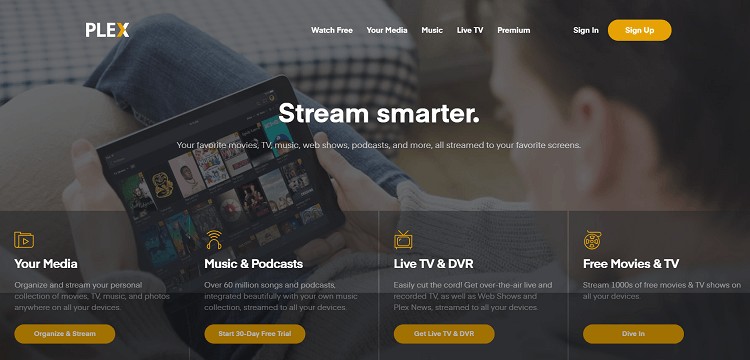There’s a bit of a misunderstanding when it comes to the idea behind cord-cutting. It’s not that people don’t want to watch TV, it’s just that they would rather do it in a way that is convenient and keeps up with the technology that is available. Cable is outdated and expensive, but that doesn’t mean the medium of TV has to go away with it.
The question they ask then is, “How do I continue to be able to use television, without having to deal with cable companies?”
Through a combination of the media server known as Plex and an IPTV service, this is entirely possible.
What is Plex?

In the simplest terms possible, Plex is an all-in-one media program that can be run on a wide array of devices. It takes the user’s videos, pictures, and music that are stored on a device running a Plex server and can then stream that to any device capable of running the Plex app.
Using Plex
To get Plex to work, simply install the Plex Media Server onto a compatible device. This includes computers running all major operating-Linux, MacOS, Windows- as well as NAS Devices or the . Most anything capable of installing software and holding storage will work.
Once the server is running, the next step is to download the app onto whichever device you’d like to stream to. There’s a wide list of products that support the Plex app not limited to:
- All Major Web Browsers
- Smart TVs
- Smart Phones
- Video Game Consoles
- Other TV streaming devices such as the or the Amazon Firestick.
All this is great, but the feature that really makes this system so worthwhile for cord-cutters is that Plex can also be used to stream live TV from IPTV services, but only if set up properly.
What is IPTV?
Most people have been using IPTV for a while now, even if they aren’t aware of it. With the advent of streaming services such as Netflix or Hulu, IPTV sort of barrelled into modern-day living.

IPTV stands for Internet Protocol Television. It’s just as it sounds. Instead of using fiber optics or airwaves to transmit television programming to a set, IPTV delivers the programming via the internet. This allows for a wider array of programming choices that aren’t set at the whims of whatever cable company is in the area.
IPTV comes in a few different formats:
Video on Demand (VOD)
Pretty much everyone is familiar with this concept at this point. The aforementioned Netflix and Hulu are good examples of VOD, as well as Amazon or Vudu or the litany of other movie streaming services out there.
Android TV Box Bestsellers
It’s by far the most convenient type of streaming available, but newer programming tends to be kept a bit closer to the vest by broadcasting companies. This has led to:
Time-shifted Media
This format is gaining popularity as more and more people join the movement. The concept here is that the broadcasters will let watchers view the media whenever they want, but during a limited time frame.
Certain websites offer this now, such as with the BBC. Viewers don’t get the chance to rewatch an entire season whenever they want, but if they need to catch up on an episode or two they are generally available.
Live IPTV
Another term that is basically exactly what it sounds like. The difference between this and regular television is solely the medium by which it is being broadcast. It does, however, allow certain special events to be seen without having to go through expensive PayPer View services. This is very popular with sports fans.
Requirements for IPTV to run on Plex
Until the middle of last year, this was a simple matter of installing the proper plug-ins within the media server. Since then Plex has removed support for plug-ins, so things have gotten a bit more complicated as they no longer support IPTV directly. Directly, being the keyword.
IPTV Tuners
Plex allows for use of TV Tuners within the server. Through these, IPTV streaming from a Plex Media Server is entirely possible, though indirectly, and actually comes with some pretty handy features such as channel filtering and DVR.
Two of the most popular TV Tuners at the moment are both free and open-source, xTeVe and TVTelly. Installing these onto a Plex Media Server is fairly straightforward, especially with xTeVe, but it must be done manually. Both of the services’ wikis have setup information for xTeVe and for Telly.
My personal recommendation is for xTeVe just for the ease of installation and the quality of the UI.
Plex Pass and an IPTV Subscription
To live stream television through a tuner on Plex, you do require a subscription to their service to the tune of $4.99 a month and less if purchasing multiple months at a time. This is, of course, much cheaper than cable but it is something to be aware of before jumping head first into this wild world.
Slow Streams or Buffering?
Are your streams loading too slow? Getting constant buffering? Not able to stream at full resolution? Check out these tips to improve your streaming experience:
- Use a modern Router that has advanced features like QoS to prioritize video content. Check out our recommended Routers for Streaming.
- If you are using a Wifi connection, be sure to check out our 9 easy steps to improve your Wifi for Streaming.
- Some Internet Service Providers throttle video streaming traffic without telling their customers. A VPN encrypts all your traffic and circumvents throttling, blocking and geographical restrictions.
Furthermore, an IPTV subscription is also required from one of the many providers on the net. They provide the necessary m3u files that the tuners can stream from. These include IconicIPTV or SportzTV as well as many others, some are free and some are not. The paid ones generally are much more consistent, but the choices are quite numerous at this point.
XML EPG Data and a VPN
Neither of these is explicitly required, but make functionality much better.
XMLTV listings (EPG data) are not provided by Plex. Though Plex offers a decent line up for TV listing data with their pass in the form of an EPG (Electronic Program Guide), certain streams in certain countries may not be included. Using an outside source of XML data removes this issue entirely. Plex has a fairly good list of sources for various countries. The gist is, to get the most comprehensive TV guide list, a good XML source is great to have. Luckily, virtually any IPTV service will provide you a matching xmltv data file that you can use to get the best EPG coverage possible.
Furthermore, adding a VPN to the equation is an excellent idea for both security purposes as well as getting around any potential country locks from a service. Even using a VPN with a VOD service such as Netflix or Hulu opens up a huge amount of potential programming options that are blocked off in certain countries.
There’s plenty of quality VPN’s on the net. However, a paid option is all but mandatory to maintain consistent streaming speed and quality. PureVPN is a popular and secure choice that is on the lower end of the pay scale for this type of service.
Furthermore, it’s a great way to keep one’s privacy. Most of the content that is streamable from IPTV is perfectly legal, however, when 1000’s of TV stations are in the mix it can become a bit questionable over who is paying for some of these services. VPNs protect users in these cases.
Why Use Plex for TV Streaming?

Though it may seem like a bit of a handful, the process of getting IPTV on a Plex Media Server is pretty straightforward and doesn’t take much time. The reward for the process is the ability to stream just about any program from around the world on pretty much every major media device, for much less than the cost of regular cable.
Pros
- Cost-effective
- Many more programs than standard TV
- Available anywhere there is internet service
- A huge amount of supported devices
- Less beholden to cable companies
Cons
- Certain IPTV providers can be unreliable
- Requires an amount of work to get up and running
- A few cheap subscriptions versus one expensive one
- Questionable legality in some cases
A fully set up Plex server with IPTV running properly is truly an impressive, cool, and just straight up a convenient way to view programming. It is the future of television without a fragment of a doubt.
Last update on 2025-12-24 at 16:26 / Affiliate links / Images from Amazon Product Advertising API. As an Amazon Associate I earn from qualifying purchases.